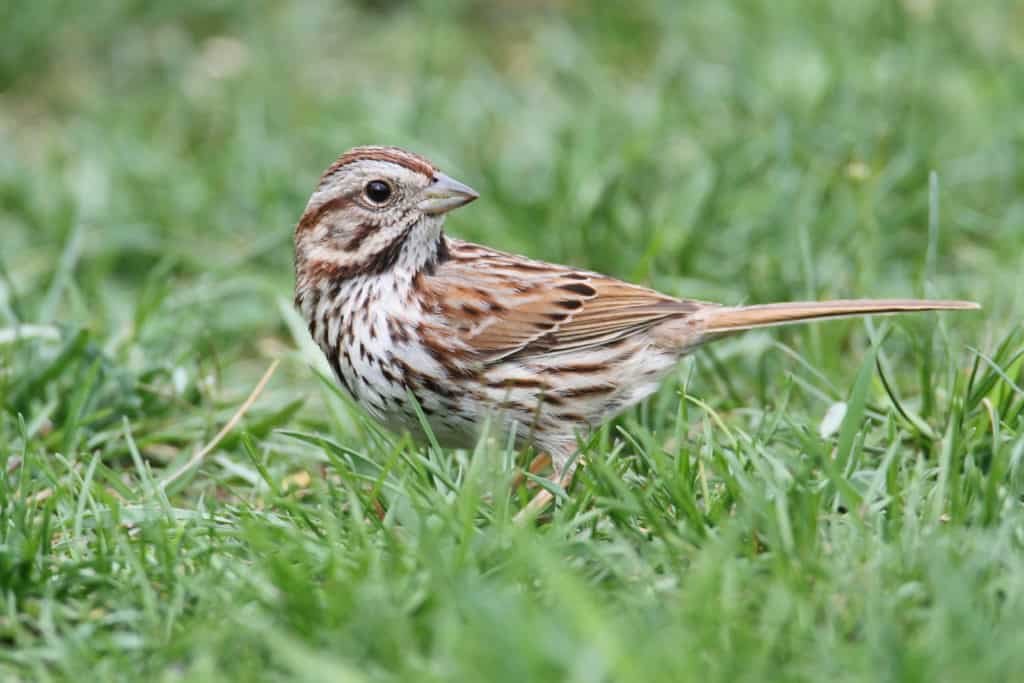There are many challenges that come with planting grass seed. However, many people do not factor in birds as a potential problem to successfully growing a lush lawn from seed.
Birds are a problem because they eat grass seed.
Speaking from experience, I had a patch of lawn in my front yard that died off from grub damage over one summer. To establish new grass, I simply covered the dead spot with lawn soil, spread the seed over the top, lightly raked in the seed, applied starter fertilizer, and then watered twice a day.
Since the seed wasn’t all completely buried, birds had access to it if they happened to stumble upon it. I am notorious for bad luck so, of course, the birds found it. This was not just one or two birds, but a whole flock. When I observed the damage, they did indeed have a nice buffet of the seed.
I have since planted grass seed many times and have not had a problem with birds since. I used the peat moss method mentioned below along with coated seed to deter birds. However, we included a few other methods that should also work just as well.
Table of Contents
How to protect grass seed from birds?
Here are some ways you can consider protecting your grass seed from birds:
Peat Moss
After the seed has been planted, toss on some peat moss. The peat moss will create a top layer that will shield the seed from birds and pest. It will also help prevent the seed from washing away during a heavy rain or watering. The peat moss is beneficial for helping keep the seed moist, providing nutrients and conditioning the soil.
Too much peat moss can deter seed growth and potentially cause problems with the seed remaining too moist. Only a light layer of peat moss should be used. It will decompose rather quickly. You can apply another light dusting if needed.
Mesh or Chicken Wire
Mesh or chicken wire can be raised slightly over the seeded area to prevent birds. The spacing in this material is enough to allow water, sunlight, and other nutrients to make their way to the seeds. Of course, this method is only practical for small areas at a time. If you are seeding a half acre, for example, the cost and the labor are just too much for most people.
Straw
Straw is a popular choice to cover grass seed to prevent it from moving around from the wind and rain. It also helps keep the seeds moist and provides a nice shield to hide the seed from hungry birds.
You have to be careful when purchasing straw because it may contain weeds. In other words, the straw may have weed seed on the straw that will germinate along side the grass seed.
If you are going to use straw, make sure the packaging states it is near 100% weed free. For example, this EZ-Straw found on Amazon, is 99% weed free according to the packaging.
Scare Tactics
There are numerous products out there that are designed to scare off birds and other animals. These products include fake owls, snakes, scarecrows, motion activated sprinklers, reflective discs, and many more. Set one of these adjacent to the planted grass seed to deter birds. However, avoid predictability and frequently move the scare item or device to different locations.
Protective Seed Coatings
The type of seed you use can make a big difference on whether birds will eat it or not. A study on captive sparrows and grass seed published in TurfGrass Trends found that these birds had a clear preference between traditional seed versus encapsulated seed that contained mulch, non-toxic fiber, soil conditioners, and fertilizer.
The traditional seed was the overwhelming favorite of the sparrows in the study. The encapsulated seeds was generally avoided. If you suspect birds will be a problem, look for encapsulated grass seed such as EncapSeed used in the study or something like this Scotts Kentucky Blue Mix that is coated.
Bird Seed
Providing birds with bird seed that is placed a distance away from the grass seed will keep the birds full and satisfied. They likely won’t seek out additional food sources if they are well fed from the bird feeder. Of course, you have to keep the feeders full or the grass seed may be the next course of the meal plan.
Dog or Cat
A dog or cat roaming the yard can be an excellent deterrent of birds. This is especially true for a pet that is more active compared to one that sleeps under a bush all afternoon. However, there is some obvious risk to the birds when the dog or cat is outside. According to USA Today, cats kill up to a staggering 3.7 billion birds per year. It is also not uncommon for certain dogs to catch and kill birds.
Fast Growing Seed
The quicker the grass seed grows, the less time birds have to devour the seed. Not all types of grass seed germinates at the same rate. For example, Kentucky bluegrass is notorious for taking a few weeks to germinate whereas perennial ryegrass can germinate within a few days. Check out our article on how to grow grass fast for more information.
Conclusion
Since there is a real possibility that birds will eat grass seed, preventative measures should be put into place to deter them. This is especially true given that most grass seed is not cheap and it takes a decent amount of labor time to prepare and grow the seed. A solid plan prior to laying down grass seed is always the best route to the path of achieving your ideal lawn.

